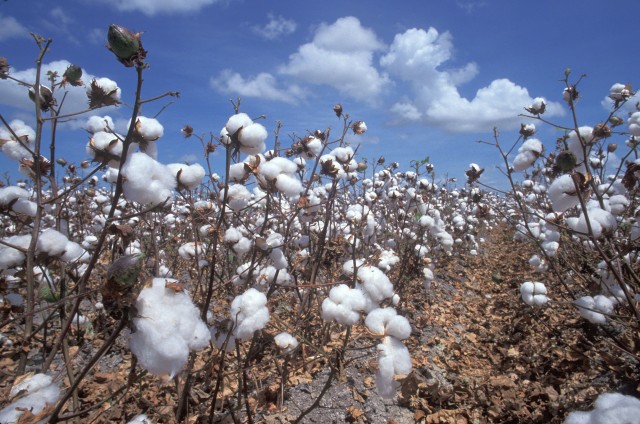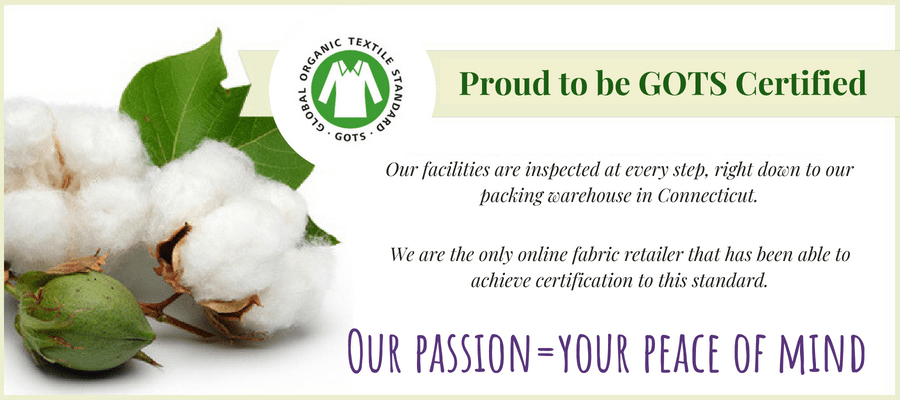When I started this blog two years ago, at the suggestion of multiple friends who noted my frequent fact-sharing and opining on Facebook about various sustainability topics, I really didn’t know how long I would keep it going. I didn’t expect to make it to my 53rd post one year ago, and I certainly didn’t expect to hit my 105th today. Before I get into the meat of this week’s topic, I want to thank every one of you who reads, likes, and comments on my posts every week (or on occasional weeks).
If not for this blog, I would still be researching interesting topics on my own, but knowing that people do actually read what I write and furthermore find it useful(!) ensures that I continue the routine of setting time aside each week to process and share what I’ve learned. As we used to joke at my college, “once you do something twice, it’s tradition.” And so, here is my traditional anniversary post, this year highlighting the traditional second anniversary gift: cotton.
Cotton gets a lot of positive and negative press, making it difficult to determine what is truth and what is greenwashing. It is a natural fiber, which carries with it a green, eco-friendly image, and it has had a very good marketing team behind it, at least for as long as I can remember (it’s “the fabric of our lives,” after all [1]). However, this pervasive crop is also incredibly resource intensive, resulting in massive amounts of land, water, and pesticide use. Aside from environmental impacts, supply chains frequently exploit workers in poorer countries. With my own attempts to limit plastics / synthetics in my own wardrobe, the last thing I want to do is increase harmful impacts in other ways.
History of Cultivation
There is archeological evidence of cotton products dating back to 5500 BC in South Asia, and around 4200 BC in South America. The plant itself is found all over the world, and it produces a “boll” or protective casing of fibers around its seeds. To create cotton products, the fibers were picked from the plants and cleaned by hand. This process was incredibly time consuming, but the result after spinning and weaving was a soft, breathable, absorbent fabric.[2]

Image credit: [3]
Cotton has been grown all over the world for centuries, but India, the United States, China, Brazil, and Pakistan lead global production today. The invention of the cotton gin in 1793 was what really kicked production into high gear, as it could quickly and easily clean the cotton by scraping the fibers through openings too small for the seeds.[4]
Longer fibers mean higher quality cotton, with Egyptian and Pima cotton bringing top dollar today. As with pretty much any cultivated crop, favorable traits have been selectively bred over centuries. A more modern shortcut, though, is introducing Genetically Modified traits, such as resistance to certain pesticides and inherent toxicity to common pests. “Bt cotton,” as it is known, is a genetically modified, pest-resistant strain of cotton that produces its own insecticide. It was a joint venture between Monsanto and India’s Mahyco, first approved for commercial use in the US in 1995.[5]
The naturally produced toxin in Bt cotton specifically targets cotton’s primary pest (the bollworm), cutting down on the amount of pesticides needed. This is actually a benefit to insects not targeted by the plant’s toxicity. It was interesting to see that aphids were not impacted by the toxin, so in the absence of spraying pesticides on Bt cotton, a 2012 study out of China “concluded that Bt cotton halved the use of pesticides and doubled the level of ladybirds, lacewings and spiders” found in the fields. Ladybugs and lacewings love aphids and are an excellent alternative to pesticides.[6]
Production and Exploitation
Historically, cotton has been such a profitable crop in part because of the cheap labor used to grow, pick, and clean it. Slave labor used in the American south comes to mind in a much more familiar narrative to many of us, but so does the relationship between India’s laborers (paid pennies a day to produce the cotton) and England’s workers (paid shillings to spin and weave the cloth, which was then sold back to India at significantly higher prices). This manner of exploitation was why Gandhi said that it is “the patriotic duty of every Indian to spin his own cotton and weave his own cloth.”[7]
In doing my research for this post, several sources reminded me that even though something may be cheap for me (the consumer), someone had to pay for it. And cotton, which sees $2 billion in annual subsidies in the United States, is an incredibly cheap fabric. It can be even cheaper coming from countries that don’t have as stringent wage and labor standards as the US. One way around the concern of ethical labor practices is to purchase Fair Trade cotton. Fair Trade certification is most often tied to cotton coming from India and some African countries, such as Mali, Senegal, Cameroon, and Burkina Faso.[8]

Image credit: [9]
However, there are additional concerns related to equity and cost when genetically modified crops come into the picture. GM seeds are more expensive than regular seeds, and some farms continue to use the same amount of pesticides to take care of the insects that aren’t affected by Bt cotton, resulting in a higher cost of goods sold and a narrower profit margin. Many farmers go into extreme debt to buy GM seeds and other conventional products such as pesticides and fertilizers. Since 1995, more than 270,000 Indian cotton farmers have committed suicide because of that debt.[10]
Conventional vs. Organic
I have not painted a great picture of cotton so far. Conventional cotton includes some serious concerns, such as the use of harmful chemicals and GMOs, high water need, and soil erosion. There is another option, however, that has some significant benefits: organics. Organic cotton has lower water and energy needs, does not use synthetic agricultural chemicals or GMOs, and does not contribute to high levels of soil erosion.[11]
We know that cotton is generally an incredibly water-intensive crop. It takes approximately 8-10 thousand liters of water to produce 1 kilogram of cotton, though hotter, drier areas require more. There seems to be some disagreement about how water use changes between conventional and organic production. Many sustainability-focused sites quote a significantly lower water consumption rate for organic cotton, as much as 91% less![12]
On the other hand, Cotton Inc. states that it could take twice as much water to make an organic cotton t-shirt as a regular cotton t-shirt,[13] presumably because crop yields can be up to 25% lower for the same amount of land.[14] It is worth pointing out, though, that these calculations and comparisons rely greatly on specifics of each region in which it is grown. If the farm is in a place that gets a lot of rainwater, irrigation will be less of an impact factor, and vice versa. As we’ve seen before, when conducting a Life Cycle Analysis, apples-to-apples comparisons are a must.

Image credit: [15]
One Life Cycle Analysis of organic cotton stated that “organic farming (before actual production) was ‘significantly more environmentally friendly.’ It also found that organic cotton farming is less likely to contribute to global warming, acidification, and eutrophication than conventional cotton farming.”[16]
If you decide to purchase organic, keep an eye out for organic certifications, such as GOTS,[17] USDA-NOP,[18] Organic Content Standards,[19] IVN,[20] and Naturland.[21] Looking for a certification stamp is the only way to be sure it’s actually organic.
Reduce, Reuse, and Recycle
Fair trade, organic cotton is the best way to go from an ethical and environmentally friendly standpoint, but it’s not without impact. You can further lessen your footprint by following the Three Rs – and going in that order.
- Reduce: Fast fashion is the name of the game these days. Purchasing only what you really need and want, and making an investment in a quality piece of clothing will do more to reduce your impact than picking cheap pieces that only last through a few wears.
- Reuse: Conventional cotton isn’t nearly as bad if you buy it second-hand. Whether from a brick and mortar thrift store or an online alternative, second-hand clothing doesn’t require any additional resources associated with farming or production, which means a huge savings for the environment and for your wallet.
- Recycle: 765,000 liters of water can be saved per ton of cotton recycled,[22] but each American sends on average 70 lbs of textiles to the landfill every year. If you can’t mend or repurpose clothes that are at the end of their useful life, there are many companies that recycle clothes and fabrics, and you can check out a substantial list of options here.[23]
I hope this post has provided you with some new information about a material so common in our lives that we rarely give it a second thought.
Happy Cotton Anniversary, and thank you for reading!
[1] https://www.youtube.com/watch?v=upd9AtdeAoE
[2] https://en.wikipedia.org/wiki/Cotton
[3] https://arstechnica.com/science/2016/09/transgenic-cotton-plant-resistant-to-common-insect-pest/
[4] https://www.youtube.com/watch?v=QPPfFHF7nvg
[5] https://en.wikipedia.org/wiki/Bt_cotton
[6] https://www.youtube.com/watch?v=EOwk3PRTmEw
[7] https://www.ncbi.nlm.nih.gov/pmc/articles/PMC2156064/
[8] https://www.fairtrade.net/impact/key-data-fairtrade-cotton
[9] https://bambubatu.com/gandhi-on-the-economy-of-cotton/
[10] https://www.sustainyourstyle.org/en/fiber-ecoreview
[11] https://www.sustainyourstyle.org/en/fiber-ecoreview
[12] https://www.theworldcounts.com/challenges/consumption/clothing/cotton-farming-water-consumption/story
[13] https://cottontoday.cottoninc.com/
[14] https://www.nature.com/articles/nature11069
[15] https://organiccottonplus.com/
[16] https://store.textileexchange.org/wp-content/uploads/woocommerce_uploads/2019/04/LCA_of_Organic_Cotton-Fiber-Full_Report.pdf
[17] https://www.global-standard.org/
[18] https://www.ams.usda.gov/rules-regulations/organic
[19] https://textileexchange.org/matrix/organic-ocs/
[20] https://certifications.controlunion.com/en/certification-programs/certification-programs/ivn-naturtextil
[21] https://www.ecocert.com/en-US/certification-detail/organic-farming-private-naturland
[22] https://www.sustainyourstyle.org/en/fiber-ecoreview
[23] https://trashisfortossers.com/how-to-recycle-old-clothing
1 Comment
Tidying Up, Week 2 – Radical Moderate · February 21, 2021 at 10:01 am
[…] [6] https://radicalmoderate.online/cotton-and-its-impacts/ […]